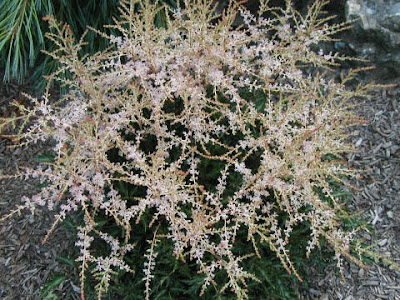 |
Top (Left to Right) Gaillardia, Liriope, Heuchera
Bottom (Left to Right) Coreopsis, Salvia May Night, Astilbe 'Sprite' |
Perennials play such an important role in adding lasting beauty to the landscape and there are so many wonderful long-blooming perennials for the zone 7 northeastern garden. In this article I will discuss some of my all time favorite perennials for overall performance, hardiness, excellent foliage and long lasting blooms.
 |
| Gaillardia 'Goblin' |
First there is Gaillardia 'Goblin', or Blanket Flower, which produces red to yellow bi-color blooms throughout June to August on 12" stems. It is hardy in zones 4-8 and repeats its performance year after year if grown in full sunlight. Gaillardia prefers well-drained soil, is considered drought tolerant and does not require abundant watering once established.
 |
| Liriope muscari 'Variegata' |
Liriope muscari 'Variegata' is popular for its grass-like, cream or yellow-margined leaves. Liriope can be grown in sun or shade and produces small purple blooms in August to September followed by round, dark purple berries. Liriope is very versatile as it can be planted just about anywhere in the garden as a complement to other plantings and is hardy in USDA zones 4-10.
 |
| Heuchera 'Palace Purple' |
One of my favorite perennials for shade is Heuchera. From experience I find Heuchera 'Palace Purple' to be the most hardy with beautiful burgundy foliage. The delicate white flowers produced on 12 inch stems in August to September that resemble baby's breath are just an added bonus. Heuchera can be grown in partial sun to shade and prefers a moderately moist organic soil. It is hardy in zones 4-8.
 |
| Coreopsis 'Zagreb' |
Coreopsis 'Zagreb' is a popular favorite for areas of full sun and produces yellow daisy-like blooms from June to July that last throughout August on 12-18 inch fern-like stalks. Coreopsis is deer resistant, prefers a well-drained soil and can withstand drought-like conditions once established. I find this perennial to be highly reliable and very hardy in zone 7. Coreopsis will spread so plant it in a place where you have plenty of room and enjoy its beauty. Coreopsis is complemented nicely by either salvia or nepeta.
 |
| Salvia 'May Night' |
Salvia 'May Night' displays beautiful deep purple flowers on 12-18 inch stalks from the end of May through July. To extend the bloom time of your salvia all the way into fall simply prune off spent flower stalks as new ones arise and the plant will continue to produce more blooms! Salvia prefers to be grown in full sun in zones 4-8 and can tolerate some drought. It is also deer resistant.
 |
| Astilbe 'Sprite' |
The next selection for shady areas is Astilbe 'Sprite'. This perennial displays bronze foliage with pale pink flowers in late July to August on dwarf 12 -14 inch plants. There are several other wonderful varieties of astilbe but in my opinion this variety has the nicest foliage and the most delicate blooms. Astilbe 'Sprite' prefers to be grown in partial sun to shade in an organic, moderately moist soil and is hardy in USDA zones 4-9.
 |
| Daylily 'Stella D'Oro' |
There are two more of my of my all time personal favorites that cannot go by without being mentioned. The first is Daylily 'Stella D'Oro'. There are many varieties of daylily but this semi-fragrant, golden yellow repeat bloomer will continue to produce blooms on 12-18 inch stalks from June until fall with some pruning. This perennial prefers to be grown in full sun and complements many other perennials such as heuchera, liriope, salvia and nepeta and is hardy in USDA zones 3-9.
 |
| Nepeta 'Walkers Low' |
The second is Nepeta 'Walkers Low', a dwarf form of nepeta with gray-green aromatic foliage and large violet-blue flowers that bloom all summer long. Nepeta 'Walkers Low' is drought tolerant and deer resistant. It can be grown in full sun to partial shade and forms round compact mounds. This perennial goes well with coreopsis, daylily and heuchera and is hardy in zones 3-8.
It is almost impossible to narrow down the best of the best perennials for your garden and there are thousands to choose from but I am hoping that this article will give you a brief idea of the possibilities that are available. The perennials mentioned in this article are my favorites based on experience. They have proven to be winners over the years with excellent foliage, repeat colorful blooms and all around summer interest in the landscape.
Thank you for visiting and Happy Gardening!
Author: Lee@A Guide To Northeastern Gardening Copyright 2011. All Rights Reserved





































